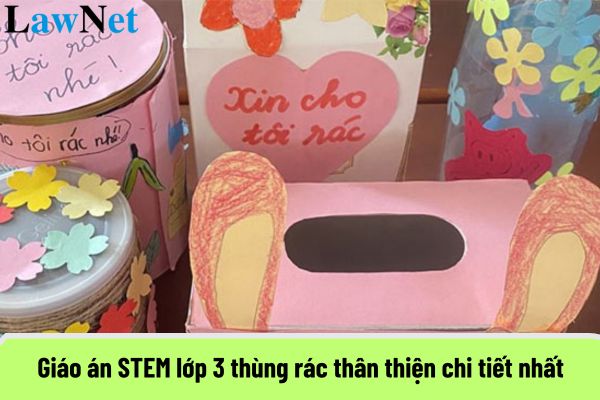What is the 3rd-grade STEM lesson plan on friendly trash bin? How is 3rd-grade STEM education in Vietnam organized?
What is the 3rd-grade STEM lesson plan on friendly trash bin?
The 3rd-grade STEM lesson plan on friendly trash bin is an opportunity for students to practice creative skills while enhancing their awareness of environmental protection through specific hands-on activities. The lesson not only helps students understand the importance of waste segregation but also encourages them to participate in environmental protection activities in schools and the community.
Teachers may refer to the following 3rd-grade STEM lesson plan on friendly trash bin:
|
3rd-grade STEM lesson plan on friendly trash bin I. Lesson Objectives |
*Note: The information is for reference only./.

What is the 3rd-grade STEM lesson plan on friendly trash bin? How is 3rd-grade STEM education in Vietnam organized? (Image from the Internet)
How is 3rd-grade STEM education in Vietnam organized?
According to sub-section 2, Section 2 of Official Dispatch 909/BGDDT-GDTH 2023, the organization of STEM education in primary education is clearly stated as follows:
*STEM Lessons
- Teaching STEM lessons in subjects is an organizational form that integrates intra-discipline or inter-discipline teaching. This is the primary form of deploying STEM education in schools to effectively implement the General Education Program at the primary level.
- The content and requirements needed for STEM lessons align closely with the objectives of subjects/educational activities in the General Education Program at the primary level.
- The duration allocated for STEM lessons is scientifically, flexibly, and appropriately built in accordance with the psychological development and comprehension levels of students without causing overload to students and teachers and is reflected in the educational plan of the school as regulated.
- The process of implementing STEM lessons is based on the engineering design process or scientific exploration process with activities tailored to the student's target group and uses primary-level teaching devices according to the regulations of the Ministry of Education and Training along with students’ learning supplies in subjects/educational activities, easy-to-find materials available to teachers and students.
- Encourage the use of supplementary digital resources, virtual experiments, simulations, software, which can be easily accessed and used within and outside the classroom to help students take initiative in learning.
- Student evaluation in STEM lessons is carried out as per the regulations on assessment and evaluation under the General Education Program at the primary level.
- Based on the requirements of STEM lessons, teachers evaluate students mainly through methods such as observation, interviews, assessment through learning files, student products, and activities.
- During evaluations, emphasize the process evaluations (frequent assessments) to encourage student progress, creating confidence and interest in learning for students.
*STEM Experiential Activities
- STEM experiential activities are educational STEM activities organized through STEM clubs, STEM festivals, STEM learning projects, or STEM experiential activities in real-life locations suitable to students' goals, interests, talents, and aspirations to create excitement and motivation for learning, contribute to developing capabilities, qualities, and nurturing passion and talents for students.
- STEM experiential activities are built within the school's educational plan in accordance with the conditions of the educational establishment and local reality.
- STEM experiential activities are designed based on interdisciplinary integrated teaching, addressing multiple fields requiring students to integrate knowledge and skills to propose solutions to effectively, flexibly, and creatively solve real-life problems.
- The space and time for organizing STEM experiential activities may extend beyond the school premises (production facilities, universities, research institutes, etc.), outside the time of subjects/educational activities.
*Introduction to Scientific and Technical Research
Introduction to scientific and technical research is an organizational form of STEM educational activities for students with talents, those who have initial interest in exploring, approaching scientific and technical research to solve practical problems.
Through organizing STEM lessons and STEM experiential activities, teachers identify talented students to nurture and create favorable conditions for them to get acquainted with scientific and technical research.
Educational establishments organize STEM educational activities for students to have opportunities to get acquainted with scientific and technical research under the form of a project/a research topic for individuals or student groups, with guidance from a teacher, a group of teachers, or cooperation with other social forces related to the research content (such as family, production facilities, universities, research institutes, science centers, experts, artisans, scientists...).
Based on actual situations, educational establishments may organize STEM experiential activities, and exchange days on scientific and technical research within the unit as a basis to select research topics/projects to participate in scientific and technical research playgrounds suitable for primary students.
What are the requirements for 3rd-grade STEM education in Vietnam?
Under Section 1 of Official Dispatch 909/BGDDT-GDTH 2023, 3rd-grade STEM education in Vietnam must meet the following requirements:
- Raise awareness for management staff and teachers about the position, role, and significance of STEM education in implementing the General Education Program at the primary level; unify the content, methods, and forms of organizing STEM educational activities; enhance management capability, organize STEM educational activities for teachers in primary education establishments.
- Effectively conduct STEM educational activities to support and enhance education in Science, Technology, Engineering, Mathematics, Informatics, and Arts; create excitement, spark passion for learning, help students discover their potential, explore science and technology, foster creativity, and apply them to solve problems in the specific context of real life.
- Organize STEM educational activities closely aligned with the objectives needed to achieve in related subjects/educational activities, suitable for the psychological, cognitive developmental characteristics of students and the school's conditions; promote integrated teaching, without causing pressure, overload for students and teachers.

